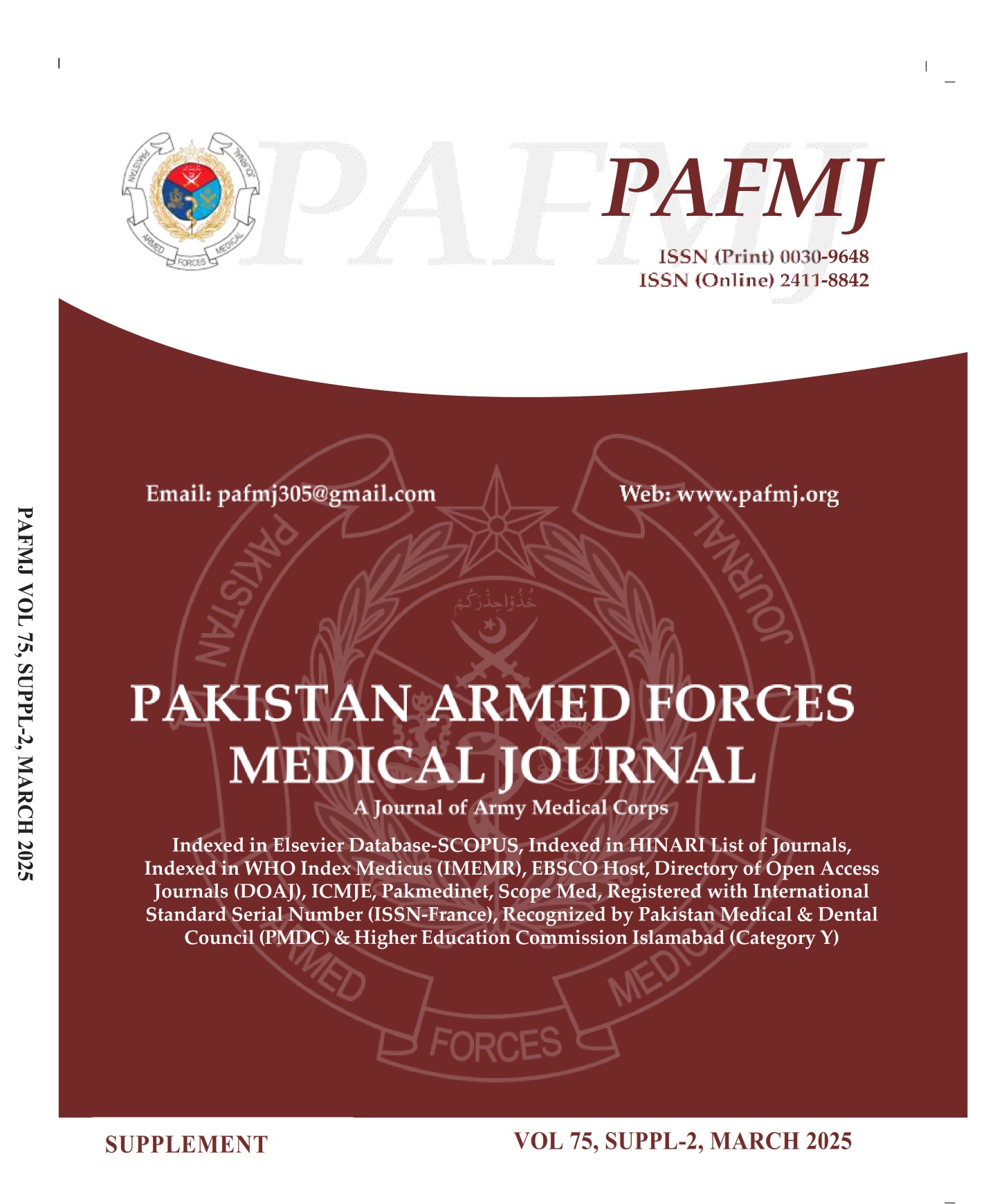Comparison of Low and High Dosage Regime of Oxytocin for Uterine Contraction in Elective Caesarean Sections Performed Under Spinal Anaesthesia
DOI:
https://doi.org/10.51253/pafmj.v75iSUPPL-2.11398Keywords:
Caesarean Section, Oxytocin and Uterine Contraction (MeSH Headings).Abstract
Objective: To compare low dose intravenous to high dose during elective Cesarean Sections.
Study Design: Quasi-experimental study.
Place and Duration of Study: Main Operation Theatre, Pak Emirates Military Hospital, Rawalpindi Pakistan, from Apr to May 2022.
Methodology: A total of two hundred term pregnant women were randomized to either 5 IU intravenous bolus group or 10 IU intravenous bolus group of Oxytocin. The difference in Hemoglobin levels (Pre-op minus post-op), tachycardia percentage, tone of uterus and need for additional “rescue” uterotonic doses/ agents, hypotension and post Oxytocin administration vomiting were assessed.
Results: The primary outcome was efficacy of both drugs in causing uterine contraction. There were 6(6.1%) patients in Low dose group who developed uterine atony while there were 5(5.3%) patients who developed uterine atony in group High dose. There were 18(18.4%) patients who developed partially inadequate uterine contraction in group LD versus 15(15.8%) patients in Group HD. There were 74(75.5%) patients who developed adequate contraction in group LD versus 75(78.9%) patients in group HD who developed adequate contraction with p-value of 0.850. The frequency of side effects was also comparable in both study groups. The estimated blood loss was as mean drop in hemoglobin was 1.77±.42 grams per deciliter in group LD versus 1.49±0.50 grams per deciliter in group HD with p-value of 0.469.
Conclusion: We concluded that use of low dose of oxytocin has similar efficacy in causing uterine contraction compared to high dose.
Downloads
References
Dujardin B, Boutsen M, De Schampheleire I, Kulker R, Manshande JP, Bailey J et al Oxytocics in developing countries Int J Gynaecol Obstet 1995; 50(3): 243-251.
Bhatu JJ, Chaudhari AB, Chauhan NR. Oxytocin versus Misoprostol used as an induction of labour in term in early rupture of Amniotic membranes. IJRCOG 2020; 9(3): 1023-1029.
Rogers C, Villar R, Pisal P, Yearley C. Effects of Syntocinon use in active management of third stage labour. Br. J. Midwifery 2011; 19(6): 371-378.
Wu Y, Wang H, Wu QY, Liang XL, Wang J. A meta-analysis of the effects of intramuscular and intravenous injection of oxytocin on the third stage of labor. Arch. Gynecol. Obste 2020; 301: 643-653.
Zeng Y, Zhang Y, Zhen M, Lao L, Ma Y, Liu L et al. Side-effects of oxytocin in postpartum hemorrhage: a systematic review and meta-analysis. Am. J. Transl. Res 2022; 14(3): 1934.
Eley VA, Culwick MD, Dennis AT. Analysis of anaesthesia incidents during caesarean section reported to webAIRS between 2009 and 2022. Anaesth Intensive Care 2023; 51(6): 391-399.
Arias F. Pharmacology of oxytocin and prostaglandins. Clin Obstet Gynecol 2000; 43(3): 455-468.
Dogru KU, Dalgic H, Yildiz KA, Sezer ZA, Madenoglu HA. The direct depressant effects of desflurane and sevoflurane on spontaneous contractions of isolated gravid rat myometrium. Int J Obstet Anesth 2003; 12(2): 74-78.
Aviram A, Salzer L, Hiersch L, Ashwal E, Golan G, Pardo J et al. Association of isolated polyhydramnios at or beyond 34 weeks of gestation and pregnancy outcome. OBGYN 2015; 125(4): 825-832.
Regitz-Zagrosek V, Blomstrom Lundqvist C, Borghi C, Cifkova R, Ferreira R, Foidart JM, et al. ESC Guidelines on the management of cardiovascular diseases during pregnancy: the Task Force on the Management of Cardiovascular Diseases during Pregnancy of the European Society of Cardiology (ESC). Eur. Heart J 2011; 32(24): 3147-3197.
Somjit M, Surojananon J, Kongwattanakul K, Kasemsiri C, Sirisom M, Prawannoa K et al Comparison of low dose versus high dose of oxytocin for initiating uterine contraction during cesarean delivery: a randomized, controlled, non-inferiority trial. Int. J. Women's Health 2020: 667-673.
Cole NM, Abushoshah I, Fields KG, Carusi DA, Robinson JN, Bateman BT et al .The interrater reliability and agreement of a 0 to 10 uterine tone score in cesarean delivery. AJOG 2021; 3(3): 100342.
Mol A, Hoang PT, Sharmin S, Reijnierse EM, van Wezel RJ, Meskers et al Orthostatic hypotension and falls in older adults: a systematic review and meta-analysis. J Am Med Dir Assoc 2019; 20(5): 589-597.
Husslein P, Fuchs AR, Fuchs F. Oxytocin and the initiation of human parturition: I. Prostaglandin release during induction of labor by oxytocin. AJOG 1981; 141(5): 688-693.
Balki, Mrinalini, Ronayne, Michael D, Davies, Sharon M et alMinimum Oxytocin Dose Requirement After Cesarean Delivery for Labor Arrest. OB/GYN 2006; 107(1): 45-50.
Robinson C, Schumann R, Zhang P, Young RC. Oxytocin-induced desensitization of the oxytocin receptor. AJOG 2003; 188(2): 497-502.
Wei SQ, Luo ZC, Qi HP, Xu H, Fraser WD. High-dose vs low-dose oxytocin for labor augmentation: a systematic review. AJOG 2010; 203(4): 296-304.
Wang Y, Yuan J, Lin Y. Effect of phenylephrine on the prevention of oxytocin-induced hypotension. J. Anesth 2022: 5(8): 1-2.
Phung LC, Farrington EK, Connolly M, Wilson AN, Carvalho B, Homer CS et al. Intravenous oxytocin dosing regimens for postpartum hemorrhage prevention following cesarean delivery: a systematic review and meta-analysis. AJOG 2021; 225(3): 250-259.
Roopasree B, Joseph J, Mukkadan JK. Oxytocin-functions: An overview. MOJ Anat. Physiol 2019; 6(3): 128-133.
King KJ, Douglas MJ, Unger W, Wong A, King RA. Five unit bolus oxytocin at cesarean delivery in women at risk of atony: a randomized, double-blind, controlled trial. Anesth. Analg 2010; 111(6): 1460-1466
Downloads
Published
Issue
Section
License
Copyright (c) 2025 Syed Ali Mazhar Rizvi, Azmat Riaz, Fatima Sharif Khan, Tariq Mehmood Malik, Umairah Yaqub, Muhammad Fawaz Amjad

This work is licensed under a Creative Commons Attribution-NonCommercial 4.0 International License.















